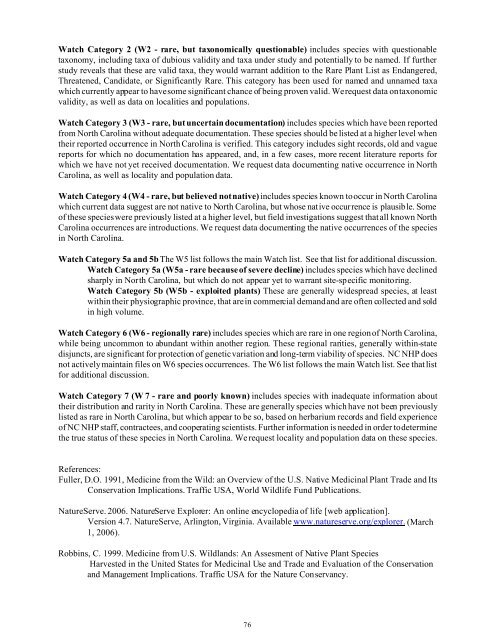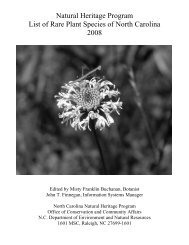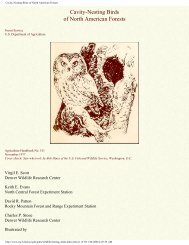Natural Heritage Program List of Rare Plant Species - Rawlings ...
Natural Heritage Program List of Rare Plant Species - Rawlings ...
Natural Heritage Program List of Rare Plant Species - Rawlings ...
Create successful ePaper yourself
Turn your PDF publications into a flip-book with our unique Google optimized e-Paper software.
Watch Category 2 (W2 - rare, but taxonomically questionable) includes species with questionable<br />
taxonomy, including taxa <strong>of</strong> dubious validity and taxa under study and potentially to be named. If further<br />
study reveals that these are valid taxa, they would warrant addition to the <strong>Rare</strong> <strong>Plant</strong> <strong>List</strong> as Endangered,<br />
Threatened, Candidate, or Significantly <strong>Rare</strong>. This category has been used for named and unnamed taxa<br />
which currently appear to have some significant chance <strong>of</strong> being proven valid. We request data on taxonomic<br />
validity, as well as data on localities and populations.<br />
Watch Category 3 (W3 - rare, but uncertain documentation) includes species which have been reported<br />
from North Carolina without adequate documentation. These species should be listed at a higher level when<br />
their reported occurrence in North Carolina is verified. This category includes sight records, old and vague<br />
reports for which no documentation has appeared, and, in a few cases, more recent literature reports for<br />
which we have not yet received documentation. We request data documenting native occurrence in North<br />
Carolina, as well as locality and population data.<br />
Watch Category 4 (W4 - rare, but believed not native) includes species known to occur in North Carolina<br />
which current data suggest are not native to North Carolina, but whose native occurrence is plausible. Some<br />
<strong>of</strong> these species were previously listed at a higher level, but field investigations suggest that all known North<br />
Carolina occurrences are introductions. We request data documenting the native occurrences <strong>of</strong> the species<br />
in North Carolina.<br />
Watch Category 5a and 5b The W5 list follows the main Watch list. See that list for additional discussion.<br />
Watch Category 5a (W5a - rare because <strong>of</strong> severe decline) includes species which have declined<br />
sharply in North Carolina, but which do not appear yet to warrant site-specific monitoring.<br />
Watch Category 5b (W5b - exploited plants) These are generally widespread species, at least<br />
within their physiographic province, that are in commercial demand and are <strong>of</strong>ten collected and sold<br />
in high volume.<br />
Watch Category 6 (W6 - regionally rare) includes species which are rare in one region <strong>of</strong> North Carolina,<br />
while being uncommon to abundant within another region. These regional rarities, generally within-state<br />
disjuncts, are significant for protection <strong>of</strong> genetic variation and long-term viability <strong>of</strong> species. NC NHP does<br />
not actively maintain files on W6 species occurrences. The W6 list follows the main Watch list. See that list<br />
for additional discussion.<br />
Watch Category 7 (W 7 - rare and poorly known) includes species with inadequate information about<br />
their distribution and rarity in North Carolina. These are generally species which have not been previously<br />
listed as rare in North Carolina, but which appear to be so, based on herbarium records and field experience<br />
<strong>of</strong> NC NHP staff, contractees, and cooperating scientists. Further information is needed in order to determine<br />
the true status <strong>of</strong> these species in North Carolina. We request locality and population data on these species.<br />
References:<br />
Fuller, D.O. 1991, Medicine from the Wild: an Overview <strong>of</strong> the U.S. Native Medicinal <strong>Plant</strong> Trade and Its<br />
Conservation Implications. Traffic USA, World Wildlife Fund Publications.<br />
NatureServe. 2006. NatureServe Explorer: An online encyclopedia <strong>of</strong> life [web application].<br />
Version 4.7. NatureServe, Arlington, Virginia. Available www.natureserve.org/explorer. (March<br />
1, 2006).<br />
Robbins, C. 1999. Medicine from U.S. Wildlands: An Assesment <strong>of</strong> Native <strong>Plant</strong> <strong>Species</strong><br />
Harvested in the United States for Medicinal Use and Trade and Evaluation <strong>of</strong> the Conservation<br />
and Management Implications. Traffic USA for the Nature Conservancy.<br />
76




